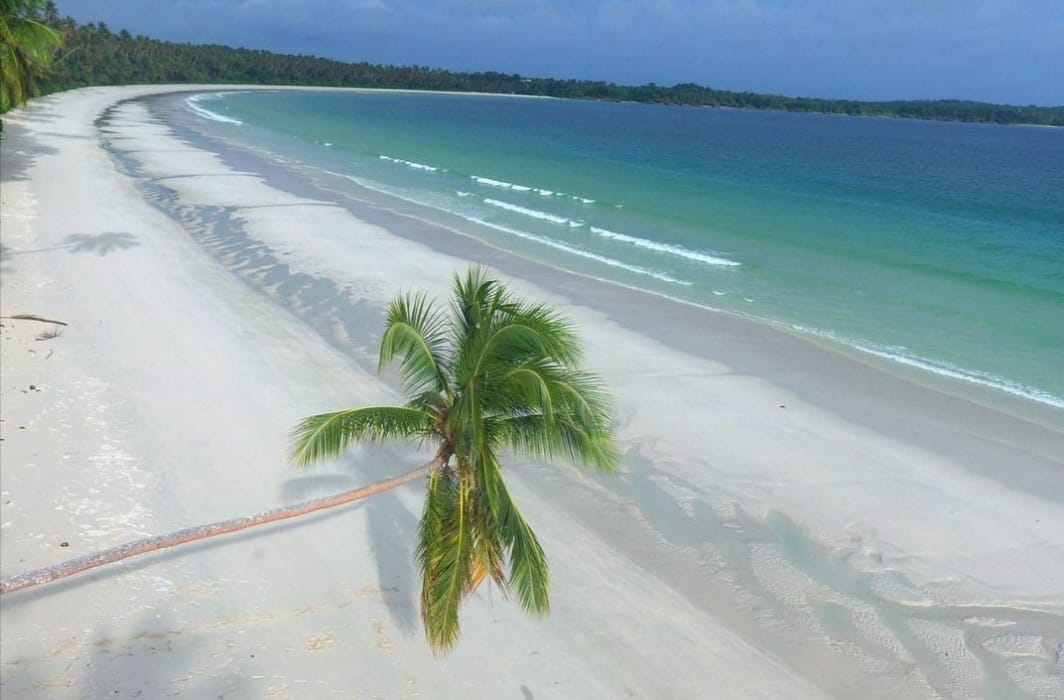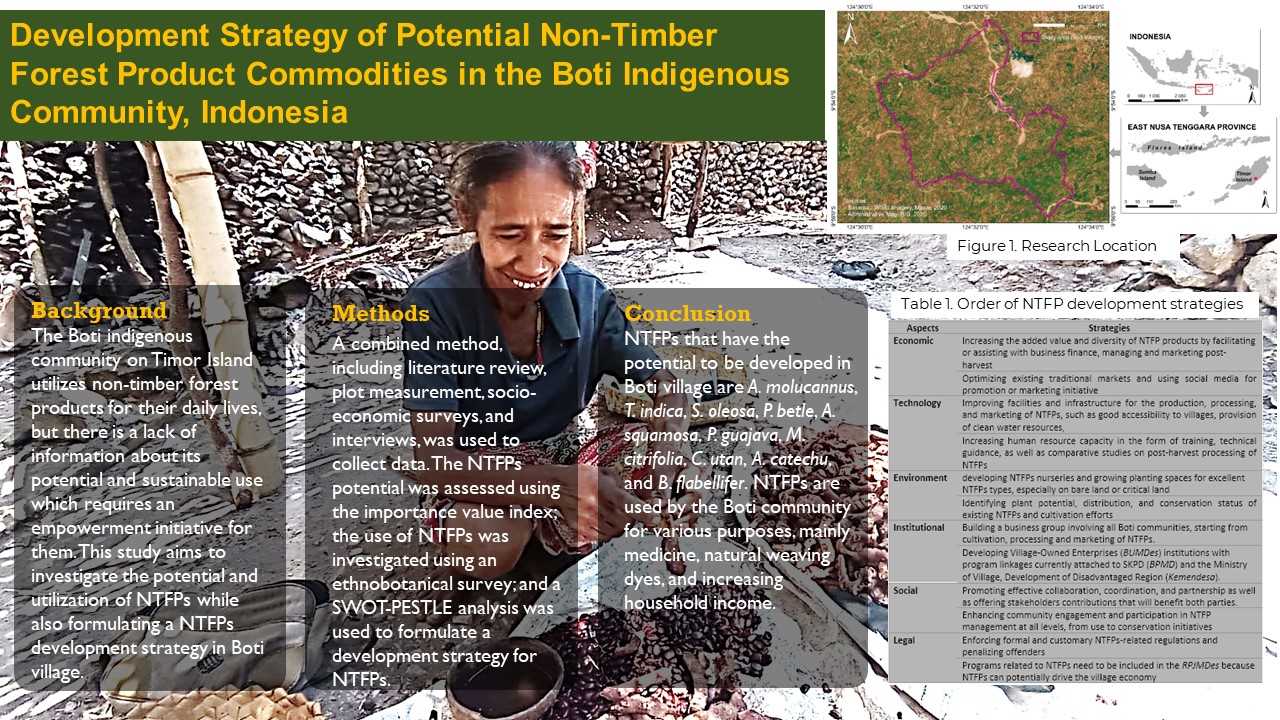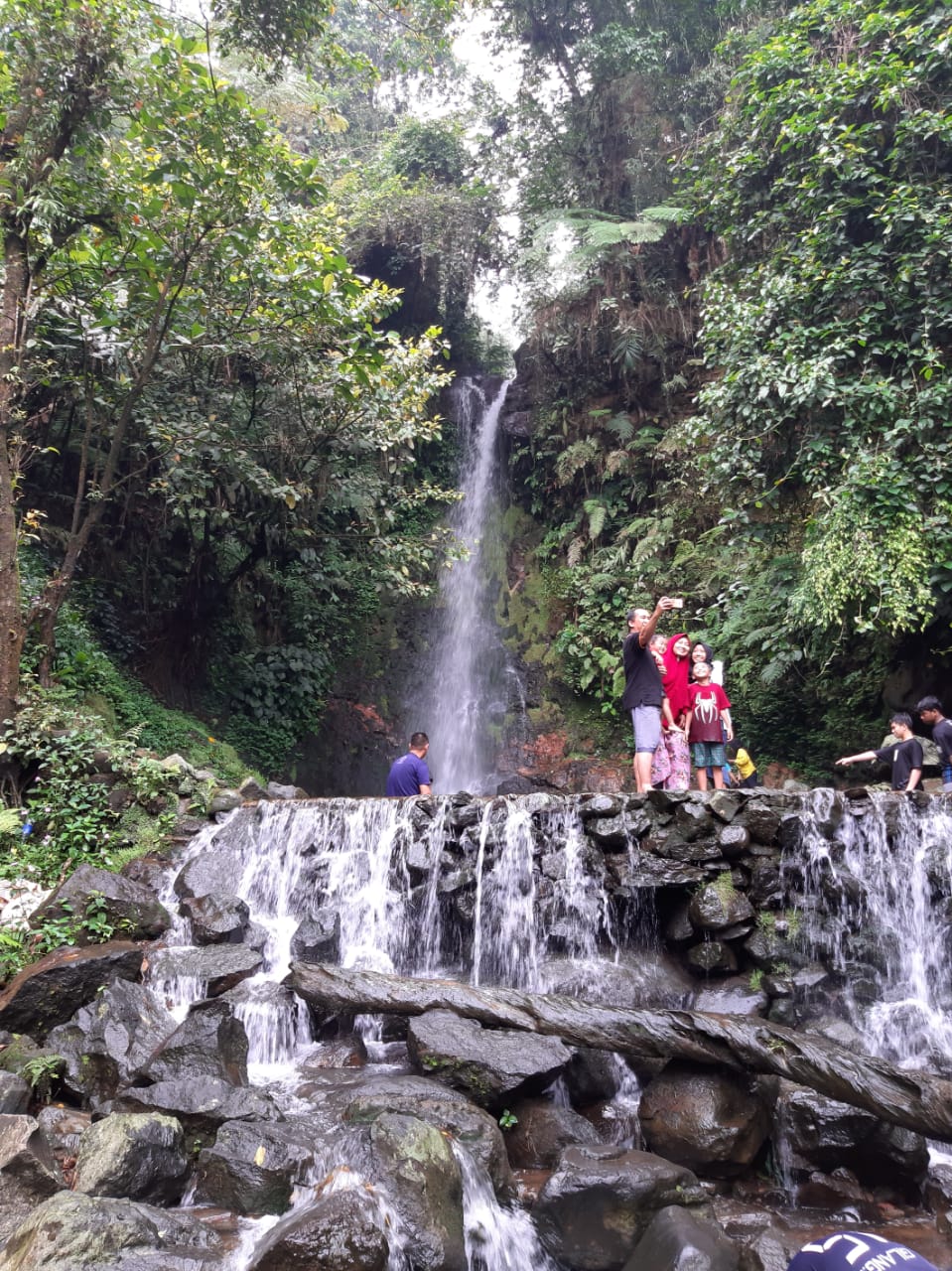Social Values Analysis Toward Ecotourism Development in The Kei Islands
Abstract
The application of carrying capacity has the potential to protect tourist areas, both natural and cultural, and it is also related to the lifestyle of the local community, as well as the potential of tourist destinations. The condition of the people of the Kei Islands who are still experiencing conflicts of interest in several areas causes a development that is not according to plan or can even change or destroy the character of natural and cultural resources. The purpose of this study was to analyze the condition of social values related to current social carrying capacity with conditions 10 years ago. The number of respondents was 600 people who come from 10 community groups. Primary data were obtained through filling out a list of questions by respondents using a closed-ended questionnaire by applying the “one score one indicator scoring system”. Data analysis was carried out in a quantitative descriptive manner based on the average value of each indicator. To find out the difference between the current condition and the condition 10 years ago, a paired t test was conducted. The results showed that the local community's response to tourism development activities both now and 10 years ago felt positive and negative impacts. The conditions of social situations that produce positive impacts are condusive situations, associations, cooperative situations, and productive collaborations, while the negative ones were dissociation, conflict, and war. Communication and economic aspects must be the attention of the parties so that conflicts of interest can be reduced so that the development of ecotourism in the Kei Islands can be more optimal.
References
Altinay, L., & Paraskevas, A. (2008). Planning research in hospitality and tourism (1st ed.). Oxford: Butterworth-Heinemann.
Andaya, L. Y. (1993). The world of Maluku: Eastern Indonesia in the early modern period. Honolulu: University of Hawaii Press.
Andereck, K. L., Valentine, K. M., Knopf, R. C., & Vogt, C. A. (2005). Residents’ perceptions of community tourism impacts. Annals of Tourism Research, 32(4), 1056–1076. https://doi.org/10.1016/j.annals.2005.03.001
Avenzora, R. (2008). Penilaian potensi obyek wisata: Aspek dan indikator penilaian. In Avenzora, R (Eds.), Ecotourism: Theory and practice. Aceh: BRR NAD-Nias.
Avenzora, R. (2013). Ekoturisme: Teori dan implikasi. In D. Darusman & R. Avenzora (Eds.), Pembangunan ekowisata pada kawasan hutan produksi. Bogor: IPB University.
Becker, R. H. (1978). Social carrying capacity and user satisfaction: An experiential function. Leisure Sciences, 1(3), 241–257. https://doi.org/10.1080/01490407809512887
[BPS] Badan Pusat Statistik. (2020). Indeks pembangunan manusia menurut Provinsi. BPS. https://www.bps.go.id/indicator/26/494/1/-metode-baru-indeks-pembangunan-manusia-menurut-provinsi.html
[BPS] Badan Pusat Statistik Maluku Tenggara. (2021). Maluku Tenggara Regency in figures. BPS Maluku Utara. https://malukutenggarakab.bps.go.id/publication/download.html?nrbvfeve=M2E2YTJmMjZiMTJkNmQwMzVmNzkyZDNh&xzmn=aHR0cHM6Ly9tYWx1a3V0ZW5nZ2FyYWthYi5icHMuZ28uaWQvcHVibGljYXRpb24vMjAyMS8wMi8yNi8zYTZhMmYyNmIxMmQ2ZDAzNWY3OTJkM2Eva2FidXBhdGVuLW1hbHVrdS10ZW5nZ2FyYS1kYWxhbS1hbmdrYS0yMDIxLmh0bWw%3D&twoadfnoarfeauf=MjAyMi0wNC0wNiAxNDo1NjowMg%3D%3D
Burns, R. C., Arnberger, A., & von Ruschkowski, E. (2010). Social carrying capacity challenges in parks, forests, and protected areas: An examination of transatlantic methodologies and practices. International Journal of Sociology, 40(3), 30–50. https://doi.org/10.2753/ijs0020-7659400302
Byron, C., Bengtson, D., Costa-Pierce, B., & Calanni, J. (2011). Integrating science into management: Ecological carrying capacity of bivalve shellfish aquaculture. Marine Policy, 35(3), 363–370. https://doi.org/10.1016/j.marpol.2010.10.016
Cooper, D. (1995). Power in struggle: Feminism, sexuality and the state. New York: New York University Press.
Dalkilic, M., Mamak, H., Gurkan, A. C., Ucan, I., & Ozmutlu, I. (2013). Elementary students’ participation in sports activities that are effective at the level of the socio-cultural factors and communication skills. International Journal of Academic Research, 5(3), 123–127. 10.7813/2075-4124.2013/5-3/B.20
Eugenio-Martin, J. L. (2020). Assessing social carrying capacity of tourism destinations with random utility models. Studies of Applied Economics, 29(3), 881–902. https://doi.org/10.25115/eea.v29i3.4419
Faturochman, F., & Widaningrum, A. (1993). Konsep dan indikator daya tampung sosial. Populasi, 4(2), 1–19. https://doi.org/10.22146/jp.11346
Ferreira, S. L. A., & Harmse, A. C. (1999). The social carrying capacity of Kruger National Park, South Africa: Policy and practice. Tourism Geographies, 1(3), 325–342. https://doi.org/10.1080/14616689908721325
Fitriyah, N. (2014). Communication in social capital development human resource development theory perspective. Jurnal Ilmiah Niagara, 7(1), 8–18. Retrieved from: http://kampus.stiabanten.ac.id/ojsstiabanten/index.php/niagara/article/view/103/92
Graefe, A. R., Vaske, J. J., & Kuss, F. R. (1984). Social carrying capacity: An integration and synthesis of twenty years of research. Leisure Sciences, 6(4), 395–431. https://doi.org/10.1080/01490408409513046
Gunawan, R. (2006). Power relations in conservation discourse: The production of politically-informed environmental anthropology. Sosiohumaniora, 8(1), 20. https://doi.org/10.24198/sosiohumaniora.v8i1.5358
Harland, P., Staats, H., & Wilke, H. A. (2007). Situational and personality factors as direct or personal norm mediated predictors of pro-environmental behavior: Questions derived from norm-activation theory. Basic and Applied Social Psychology, 29(4), 323–334. https://doi.org/10.1080/01973530701665058
Heberlein, T. A., Alfano, G. E., & Ervin, L. H. (1986). Using a social carrying capacity model to estimate the effects of marina development at the Apostle Islands National Lakeshore. Leisure Sciences, 8(3), 257–274. https://doi.org/10.1080/01490408609513075
Henisz, W. J. (2017). Corporate diplomacy: Building reputations and relationships with external stakeholders. London: Routledge. https://doi.org/10.4324/9781351287883
Ife, J., & Tesoriero, F. (2008). Community development: Alternative community development in the era of globalization. S. Manurung, N. Yakin, M. Nursyahid, translator; S. Z. Qudsy, editor. Yogyakarta: Pustaka Pelajar.
Joshi, S., & Dahal, R. (2019). Relationship between social carrying capacity and tourism carrying capacity: A case of Annapurna Conservation Area, Nepal. Journal of Tourism and Hospitality Education, 9, 9–29. https://doi.org/10.3126/jthe.v9i0.23677
[KBBI] Kamus Besar Bahasa Indonesia. (2016). KBBI Daring. https://kbbi.kemdikbud.go.id/entri/Asosiasi
Koentjaraningrat. (2009). Pengantar ilmu antropologi. Jakarta: Aksara Baru.
Kudubun, E. E. (2016). AIN NI AIN: Kajian sosio-kultural masyarakat Kei tentang konsep hidup bersama dalam perbedaan.. Cakrawala Jurnal Penelitian Sosial, 5(2), 163–190. Retrieved from: https://ejournal.uksw.edu/cakrawala/article/view/665/452
Lawang, R. (1994). Buku materi pokok pengantar sosiologi. Jakarta: Universitas Terbuka.
Leeuwis, C. (2009, June 22–26). Reflections on system innovation, innovation systems, opportunities and change. Proceedings of the First CoS-SIS International Conference on Towards Enhancing Innovation Systems Performance in Smallholder African Agriculture. Elmina, Ghana.
Mahjuddin, A. (2012). Dampak konflik terhadap pembangunan ekonomi dan tingkat kesejahteraan rakyat (Studi kasus Aceh) [thesis]. Jakarta: Universitas Indonesia.
Mankiw, N. G (Eds.). (2007). Monetary policy (Vol. 29). Chicago: University of Chicago Press.
Maryati, K., & Suryawati, J. (2003). Sosiologi 1. Jakarta: Erlangga.
Maslow, A. H. (1943). A theory of human motivation. Psychological Review, 50(4), 370–396. https://psycnet.apa.org/doi/10.1037/h0054346
McCabe, S., & Diekmann, A. (2015). The rights to tourism: Reflections on social tourism and human rights. Tourism Recreation Research, 40(2), 194–204. https://doi.org/10.1080/02508281.2015.1049022
Melkote, S. R., & Steeves, H. L. (2001). Communication for development in the Third World: Theory and practice for empowerment (2nd ed.). India: SAGE Publications India Pvt Ltd. https://doi.org/10.4135/9788132113751
Moratis, L., & Cochius, T. (2017). ISO 26000: The business guide to the new standard on social responsibility. London: Routledge. https://doi.org/10.4324/9781351278843
Moyle, B., Croy, G., & Weiler, B. (2010). Tourism interaction on islands: The community and visitor social exchange. International Journal of Culture, Tourism and Hospitality Research, 4(2), 96–107. https://doi.org/10.1108/17506181011045172
Pitana, I. G., & Gayatri, P. G. (2005). Sosiologi pariwisata. Yogyakarta: ANDI.
Purcell, R., & Beck, D. (2010). Popular education practice for youth and community development work. Exeter: Learning Matters Ltd.
Putnam, R. (1993). The prosperous community: Social capital and public life. The American Prospect, 4(13), 1–11. Retrieved from: http://www.philia.ca/files/pdf/ProsperousCommunity.pdf
Rahantan, A. S. (2014). Evaluasi dampak pemekaran wilayah terhadap kesejahteraan masyarakat di Kota Tual [dissertation]. Yogyakarta: Universitas Gadjah Mada.
Rathnayake, R. M. W., & Gunawardena, U. A. D. P. (2012). Social carrying capacity of the Horton Plains National Park, Sri Lanka. Sri Lanka Journal of Social Sciences, 35–36(1–2), 29–36. https://doi.org/10.4038/sljss.v35i1-2.7347
Saveriades, A. (2000). Establishing the social tourism carrying capacity for the tourist resorts of the east coast of the Republic of Cyprus. Tourism Management, 21(2), 147–156. https://doi.org/10.1016/S0261-5177(99)00044-8
Schramm, W. (1971, December). Notes on instructional cross-media comparisons [Working paper]. Institute for Communication Research, Standford University California. https://files.eric.ed.gov/fulltext/ED089715.pdf
Setiadi, E. M., & Kolip, U. (2011). Pengantar sosiologi: Pemahaman fakta dan gejala permasalahan sosial: teori, aplikasi dan pemecahannya. Jakarta: Kencana Prenada Media.
Sugiyono. (2015). Metode penelitian kombinasi (mixed methods). Bandung: Alfabeta.
Suwena, I. K., & Widyatmaja, I. G. N. (2010). Pengetahuan dasar ilmu pariwisata. Denpasar: Udayana University Press.
Taneko, S. B. (1993). Struktur dan proses sosial: suatu pengantar sosiologi pembangunan (1st ed.). Jakarta: Raja Grasindo Persada.
Tiwery, W. Y. (2018). Larvul Ngabal dan Ain Ni Ain sebagai pemersatu kemajemukan di Kepulauan Kei Maluku Tenggara. Sodality: Jurnal Sosiologi Pedesaan, 6(1), 8–15. Retrieved from https://jurnal.ipb.ac.id/index.php/sodality/article/view/21200/14507
Tryatmoko, M. W. (2017). Dinamika kekuasaan RAT di Kei: Antara pengaruh negara dan kapital. Masyarakat Indonesia, 36(1), 77–99. https://doi.org/10.14203/jmi.v36i1.602
Walpole, M. J., & Goodwin, H. J. (2001). Local attitudes towards conservation and tourism around Komodo National Park, Indonesia. Environmental Conservation, 28(2), 160–166. https://doi.org/10.1017/S0376892901000169
Weladji, R. B., Moe, S. R., & Vedeld, P. (2003). Stakeholder attitudes towards wildlife policy and the Bénoué Wildlife Conservation Area, North Cameroon. Environmental Conservation, 30(4), 334–343. https://doi.org/10.1017/S0376892903000353
Wu, J., Font, X., & Liu, J. (2021). Tourists’ pro-environmental behaviors: Moral obligation or disengagement?. Journal of Travel Research, 60(4), 735–748. https://doi.org/10.1177/0047287520910787
Yuliana, A. (2018). Teori Abraham Maslow dalam analisa kebutuhan pemustaka. Libraria, 6(2), 349–376. Retrieved from: https://journal.iainkudus.ac.id/index.php/Libraria/article/viewFile/3845/pdf
Authors

This work is licensed under a Creative Commons Attribution 4.0 International License.
Jurnal Manajemen Hutan Tropika is an open access journal which means that all contents is freely available without charge to the user or his/her institution. Users are allowed to read, download, copy, distribute, print, search, or link to the full texts of the articles in this journal without asking prior permission from the publisher or the author. This is in accordance with the Budapest Open Access Initiative (BOAI) definition of open access.









